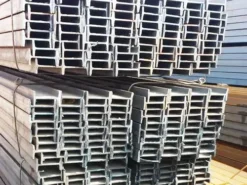Steel sheet pile is a steel structure with linkage devices on the edges, and the linkage devices can be freely combined to form a continuous and tight retaining soil or water retaining wall.
-Classification:
Steel sheet pile products are divided into two types according to production technology: cold-formed thin-walled steel sheet piles and hot-rolled steel sheet piles.
(1) Cold-formed steel sheet piles include non-bite type cold-formed steel sheet piles (also called channel plates) and bite-type cold-formed steel sheet piles (divided into L-type piles, S-type, U-type, and Z-type) Production process: Thin plates (commonly used thickness 8mm ~ 14mm) are continuously rolled and formed in a cold bending frame. Advantages: less investment in production lines, lower production costs, and flexible control of product length. Disadvantages: The thickness of each part of the pile body is similar and the size cannot be optimized, which leads to an increase in the amount of steel used. The shape of the locking part is difficult to control. The joints are not fastened tightly and cannot stop water. The pile body is prone to tearing during use.
-Chemical composition and mechanical properties of the brand:
Q345B: C≤0.20,Si≤0.50,Mn≤1.5,P≤0.025,S≤0.020,Yield Strength≥345Mpa, Tensile Strength=470-630Mpa, Elongation≥21, Impact energy≥34
Q235B: C=0.12-0.2,Si≤0.30,Mn=0.3-0.7,P≤0.045,S≤0.045,Yield Strength≥235Mpa, Tensile Strength=375-500Mpa, Elongation≥26, Impact energy≥27
(2) Hot-rolled steel sheet piles There are several major types of hot-rolled steel sheet piles in the world, such as U-type, Z-type, AS-type, H-type, etc. Production, processing and installation technology of Z-type and AS-type steel sheet piles Production technology: The steel sheet piles are formed by high-temperature rolling in a section steel rolling mill. Advantages: specifications, reasonable performance, reasonable structure, high quality, tight locking and locking structure. Disadvantages: increased technology, increased production costs, and inflexible specification series.
-Chemical composition and mechanical properties of the brand:
JIS A5523-SYW295: C≤0.18,Si≤0.55,Mn≤1.5,P≤0.04,S≤0.04,N≤0.006, Yield Strength>295N/mm², Tensile Strength>490N/mm², Elongation>17
SYW390: C≤0.18,Si≤0.55,Mn≤1.5,P≤0.04,S≤0.04,N≤0.006, Yield Strength>540N/mm², Tensile Strength>15N/mm²,
JIS A5528-SY295: Yield Strength>295N/mm², Tensile Strength>490N/mm², Elongation>17
SY390: Yield Strength>540N/mm², Elongation>15
-Shape Category
Advantage of U Type: WRU7(42kg/m),WRU8(51kg/m), WRU9(59.7kg/m)…
1) U-shaped steel sheet piles are available in various specifications and models.
2) Designed and produced according to European standards, the structure is symmetrical, which is conducive to repeated use and is equivalent to hot rolling in terms of repeated use.
3) The length can be specially customized according to customer requirements, which brings great convenience to construction and also reduces costs.
4) Due to the convenience of production, when used with combined piles, they can be pre-ordered before leaving the factory.
5) The production design and production cycle are short, and the performance of steel sheet piles can be determined according to customer requirements.
Advantage of Z Type: WRZ16-635(61.5kg/m), WRZ18-635, WRZ28-635…
1) Flexible design, with relatively high section modulus and mass ratio;
2) Higher moment of inertia, thereby increasing the stiffness of the sheet pile wall and reducing displacement and deformation;
3) Large width, effectively saving time on hoisting and piling;
4) The increased cross-section width reduces the number of shrinkage of the sheet pile wall and directly improves its water-stopping performance;
5) The parts with severe corrosion are thickened to make the corrosion resistance even better.
L Type Sheet Pile: WRL1.5
The cross-section is light, the pile wall takes up little space, and the locks are in the same direction, making construction easy. Suitable for municipal engineering excavation construction
S Type Sheet Pile: WRS4
Straight steel Type: Because of its low height and close to a straight line, it is more suitable for digging some trenches, especially when the space between two buildings is not large and must be excavated.











